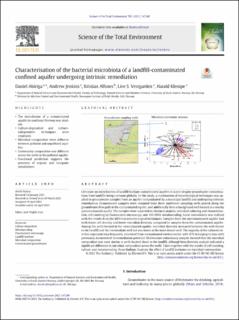| dc.contributor.author | Abiriga, Daniel | |
| dc.contributor.author | Jenkins, Andrew | |
| dc.contributor.author | Alfsnes, Kristian | |
| dc.contributor.author | Vestgarden, Live Semb | |
| dc.contributor.author | Klempe, Harald | |
| dc.date.accessioned | 2022-01-31T14:15:31Z | |
| dc.date.available | 2022-01-31T14:15:31Z | |
| dc.date.created | 2021-08-18T09:21:32Z | |
| dc.date.issued | 2021 | |
| dc.identifier.citation | Abiriga, D., Jenkins, A., Alfsnes, K., Vestgarden, L. S. & Klempe, H. (2021). Characterisation of the bacterial microbiota of a landfill-contaminated confined aquifer undergoing intrinsic remediation. Science of The Total Environment, 785, Artikkel 147349. | en_US |
| dc.identifier.issn | 0048-9697 | |
| dc.identifier.uri | https://hdl.handle.net/11250/2976078 | |
| dc.description.abstract | Literature on microbiomes of landfill leachate-contaminated aquifers is scarce despite groundwater contaminations from landfills being common globally. In this study, a combination of microbiological techniques was applied to groundwater samples from an aquifer contaminated by a municipal landfill and undergoing intrinsic remediation. Groundwater samples were obtained from three multilevel sampling wells placed along the groundwater flow path in the contaminated aquifer, and additionally from a background well located in a nearby uncontaminated aquifer. The samples were subjected to chemical analysis, microbial culturing and characterisation, cell counting by fluorescence microscopy, and 16S rRNA metabarcoding. Good concordance was realised with the results from the different microbiological techniques. Samples from the uncontaminated aquifer had both lower cell density and lower microbial diversity compared to samples from the contaminated aquifer. Among the wells located in the contaminated aquifer, microbial diversity increased between the well closest to the landfill and the intermediate well but was lower at the most distant well. The majority of the cultured microbes represent taxa frequently recovered from contaminated environments, with 47% belonging to taxa with previously documented bioremediation potential. Multivariate redundancy analysis showed that the microbial composition was most similar in wells located closer to the landfill, although beta diversity analysis indicated a significant difference in microbial composition across the wells. Taken together with the results of cell counting, culture, and metabarcoding, these findings illustrate the effect of landfill leachates on microbial communities. | en_US |
| dc.language.iso | eng | en_US |
| dc.rights | Attribution-NonCommercial-NoDerivatives 4.0 Internasjonal | * |
| dc.rights.uri | http://creativecommons.org/licenses/by-nc-nd/4.0/deed.no | * |
| dc.title | Characterisation of the bacterial microbiota of a landfill-contaminated confined aquifer undergoing intrinsic remediation | en_US |
| dc.type | Peer reviewed | en_US |
| dc.type | Journal article | en_US |
| dc.description.version | publishedVersion | en_US |
| dc.rights.holder | © 2021 The Author(s). | en_US |
| dc.source.volume | 785 | en_US |
| dc.source.journal | Science of the Total Environment | en_US |
| dc.identifier.doi | https://doi.org/10.1016/j.scitotenv.2021.147349 | |
| dc.identifier.cristin | 1926846 | |
| dc.source.articlenumber | 147349 | en_US |
| cristin.ispublished | true | |
| cristin.fulltext | original | |
| cristin.qualitycode | 2 | |

